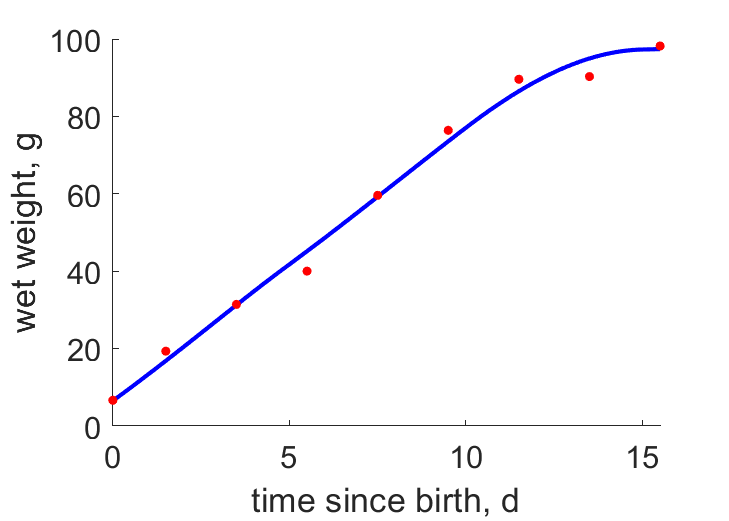Predictions & Data for this entry
| Model: std | climate: BSk, Cwa, Cfa, Dw, Df | migrate: | phylum: |
| COMPLETE = 2.5 | ecozone: TH | food: bxCi, xiO | class: |
| MRE = 0.015 | habitat: 0iTf, 0iTi | gender: Dg | order: |
| SMSE = 0.001 | embryo: Tnpfm | reprod: O | family: |
Zero-variate data
| Data | Observed | Predicted | (RE) | Unit | Description | Reference |
|---|---|---|---|---|---|---|
| ab | 16.5 | 16.74 | (0.0147) | d | age at birth | avibase |
| tx | 22 | 21.99 | (0.0006444) | d | time since birth at fledging | avibase |
| tp | 66 | 64.59 | (0.0214) | d | time since birth at puberty | guess |
| tR | 365 | 365 | ( 0) | d | time since birth at 1st brood | AnAge |
| am | 6533 | 6538 | (0.0006917) | d | life span | AnAge |
| Ww0 | 8.5 | 8.451 | (0.005792) | g | initial wet weight | avibase |
| Wwb | 6.6 | 6.458 | (0.0215) | g | wet weight at birth | avibase |
| Wwi | 163.5 | 166.9 | (0.02089) | g | ultimate wet weight for females | avibase |
| Wwim | 171.6 | 171.6 | (9.522e-05) | g | ultimate wet weight for males | avibase |
| Ri | 0.01562 | 0.01542 | (0.01233) | #/d | maximum reprod rate | avibase |
Uni- and bivariate data
| Data | Figure | Independent variable | Dependent variable | (RE) | Reference |
|---|---|---|---|---|---|
| tW |  | time since birth | wet weight | (0.03856) | Keve1985 |
Pseudo-data at Tref = 20°C
| Data | Generalised animal | Garrulus glandarius | Unit | Description |
|---|---|---|---|---|
| v | 0.02 | 0.03971 | cm/d | energy conductance |
| p_M | 18 | 516.3 | J/d.cm^3 | vol-spec som maint |
| k_J | 0.002 | 0.02092 | 1/d | maturity maint rate coefficient |
| k | 0.3 | 0.297 | - | maintenance ratio |
| kap | 0.8 | 0.9685 | - | allocation fraction to soma |
| kap_G | 0.8 | 0.799 | - | growth efficiency |
| kap_R | 0.95 | 0.95 | - | reproduction efficiency |
Discussion
- Scaled functional response varies in tW data
- Body temperature is guessed
- Males are supposed to differ from females by {p_Am} only
- mod_1: v is reduced
- mod_2: Pseudo-data point k is used, rather than k_J; Data set tp and parameter t_R are added, the latter replacing clutch interval t_N. Postnatal T is based on PrinPres1991, see get_T_Aves. See further the revision page, theme puberty
Bibliography